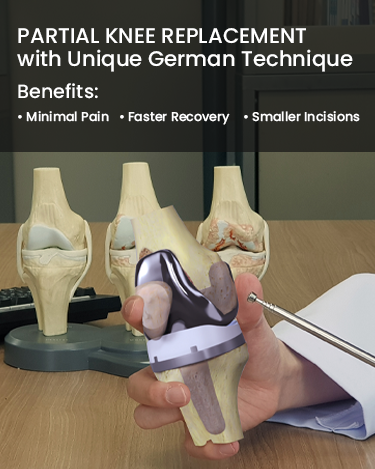PROCEDURE
Partial knee replacement is a minimally invasive knee surgery which involves smaller incisions than traditional knee surgery. It decreases the amount of post-operative pain and shortens the rehabilitation period.
Surgeons perform partial knee replacement surgeries on patients who are under below 65 years and have plenty of healthy bone remaining.
General anaesthesiais administered in the patient’s body for making the procedure pain-free. A cut of about 3 to 5 inches is made and the damaged bone tissues are removed. An artificial implant is placed into the knee and attached with the bone cement. The wounds are closed with stitches.
It is an out-patient procedure and has a faster recovery rate compared to total knee replacement surgery.
How long does partial knee procedure time?
The surgery usually takes one to two hours and involves minimal invasion.
Who can undergo partial knee surgery?
Partial knee replacement surgery is not for everyone This minimally-invasive knee replacement surgery treats only certain knee problems.Patients with inflammatory arthritis and diffuse arthritis throughout the knee are not advised for receiving partial knee surgery.
Effectiveness and recovery
Patients who have partial knee surgery are likely to experience minimal pain that can be controlled with pain medications. Recovery can be fastened by practising regular physical exercises. Patients are encouraged to walk and bear as much weight on the leg as they are comfortable.
PROS AND CONS OF PARTIAL KNEE SURGERY
There are numerous advantages of partial knee replacement but also a few disadvantages
| Pros |
Cons |
| Minimally Invasive |
Risk of implants wearing out |
| Quick Recovery |
Potential for additional surgery if arthritis develops in other parts of the knee. |
| Minimal Discomfort |
|
| Natural knee motion |
|
| No long-term activity restrictions |
|
| Low complications related to total knee replacement |
|
| All ligaments are retained |
|
PREVENTION
- Maintaining a healthy weight can prevent the knee from experiencing stress due to extra pounds, reducing the risk of injuries and osteoarthritis.
- Do balanced strength and stability training exercises.
- Invest in right quality insoles and footwear
- Do knee stretching exercises
- Massage the knee joint by applying pain-relieving gel in case of pain
- Apply hot and cold packs in case of swelling and stiffness



